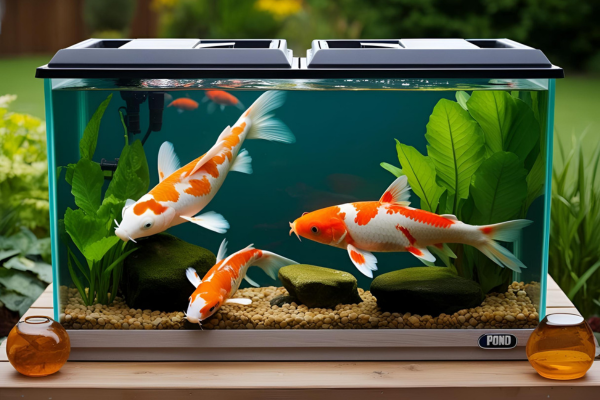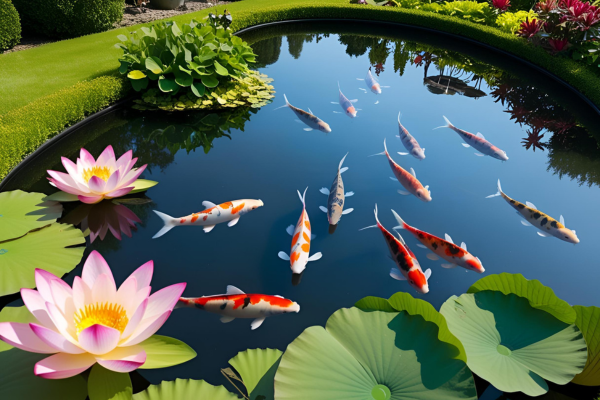Water features bring life, movement, and tranquility to any space. If you’re considering adding one to your home or garden, you might be torn between installing a koi pond or setting up an aquarium. Both options offer unique benefits, but they also come with different challenges.
Let’s break down the key differences between Koi Pond vs Aquarium aquariums to help you decide which is better for your situation, lifestyle, and preferences.
What Is a Koi Pond?
A koi pond is an outdoor water feature specifically designed to house koi fish colorful varieties of the Amur carp originally bred in Japan. These ponds are typically larger than decorative water gardens and include specialized filtration systems to support fish health.

Koi ponds have been cherished in Japanese culture for centuries, representing good fortune and perseverance. Today, they’ve gained worldwide popularity as stunning landscape features that blend natural elements with artistic design.
Key components of a typical koi pond include:
- A rubber liner or preformed shell
- Powerful filtration system
- Water pump for circulation
- Skimmer to remove debris
- Aquatic plants for balance and beauty
- Rocks and gravel for natural aesthetics
What Is an Aquarium?
An aquarium is a water-filled tank used for keeping fish, plants, and other aquatic creatures. Unlike ponds, aquariums can be placed inside your home and come in countless shapes, sizes, and styles.
Modern aquariums range from simple desktop bowls to elaborate wall-mounted displays or room-dividing installations. They offer controlled environments where you can create anything from a tiny betta habitat to a massive reef ecosystem.

Standard aquarium components include:
- Glass or acrylic tank
- Filtration system
- Heater (for tropical setups)
- Lighting
- Substrate (gravel, sand, or soil)
- Decorations and hiding places
Comparing Space Requirements
Koi Pond Space Needs
Koi ponds require significant outdoor space. For healthy koi, experts recommend:
- Minimum depth of 3-4 feet (koi need depth for winter survival in cold climates)
- At least 250 gallons per adult koi
- Typical ponds range from 500-15,000+ gallons
A modest koi pond needs at least 6×8 feet of garden space, plus surrounding area for landscaping and access. Larger is always better for koi health and water stability.

Aquarium Size Options
Aquariums offer flexibility for nearly any living situation:
- Nano tanks (under 10 gallons) fit on desktops
- Standard sizes (20-55 gallons) work in most rooms
- Large displays (75-300+ gallons) make dramatic statements
Unlike ponds, aquariums can work in apartments, condos, or homes without yards. They require just enough floor space to support their weight on appropriate furniture or stands.
Installation and Setup Process
Koi Pond Installation
Installing a koi pond is a significant project that typically involves:
- Excavation and site preparation
- Installation of underlayment and liner
- Setting up filtration and plumbing
- Adding rocks, gravel, and landscaping
- Filling and treating the water
- Cycling the pond before adding fish
This process can take several weekends for DIY enthusiasts or require professional installation, which can cost several thousand dollars.
Aquarium Setup

Setting up an aquarium is generally simpler:
- Place the tank on a suitable stand
- Add substrate and decorations
- Install equipment (filter, heater, lights)
- Fill with treated water
- Cycle the tank (establishing beneficial bacteria)
- Gradually add fish
Most people can set up a medium-sized aquarium in one afternoon, making it a more immediate gratification option.
Maintenance Requirements
Koi Pond Maintenance
Koi ponds require consistent care to maintain water quality and fish health:
Daily/Weekly Tasks:
- Check water parameters
- Remove visible debris
- Inspect equipment function
- Feed fish appropriately
Monthly/Seasonal Tasks:
- Clean filters
- Trim aquatic plants
- Partial water changes
- Add beneficial bacteria
In winter, ponds in cold climates need special attention to prevent freezing and protect hibernating fish. Spring and fall typically involve more intensive cleaning and system checks.
Aquarium Maintenance
Aquarium maintenance is more predictable year-round:
Weekly Tasks:
- 10-25% water changes
- Filter cleaning/maintenance
- Glass/acrylic cleaning
- Water testing
- Plant trimming (if applicable)
Monthly Tasks:
- Deep substrate cleaning
- Equipment checks
- Filter media replacement
While maintenance frequency is higher for aquariums, each session typically takes less time than pond maintenance usually 30-60 minutes weekly for a medium-sized tank.
Cost Comparison
Initial Investment
Koi Pond Costs:
- DIY installation: $2,000-$5,000 for a small pond
- Professional installation: $5,000-$20,000+
- Quality koi fish: $25-$300+ each (show-quality specimens can cost thousands)
Aquarium Costs:
- Basic 55-gallon setup: $300-$700
- High-end 55-gallon setup: $1,000-$2,500
- Fish: $5-$100+ depending on species
Ongoing Expenses
Both options have recurring costs for:
- Electricity (pumps, filters, heaters, lights)
- Water treatments and testing supplies
- Food
- Replacement parts
Koi ponds often have higher utility costs due to larger pumps running 24/7, but may require fewer water treatments than highly stocked aquariums.
Wildlife and Ecosystem Benefits

Koi Pond Wildlife Attraction
Outdoor ponds naturally attract and support local wildlife:
- Birds visit for drinking and bathing
- Frogs and beneficial insects find habitat
- Native aquatic plants thrive
- Contribute to local biodiversity
A well-designed pond creates a mini-ecosystem that benefits your entire garden by attracting pollinators and natural pest controllers.
Aquarium Ecosystem Control
Aquariums offer controlled environments where you can:
- Create specific biotypes (Amazon, Lake Malawi, coral reef)
- Observe rare or delicate species up close
- Maintain precise water parameters
- Prevent unwanted organisms
While less beneficial to outdoor wildlife, aquariums allow for conservation of rare species and education about diverse aquatic habitats.
Aesthetics and Design Flexibility
Koi Pond Visual Impact
Koi ponds become living focal points in your landscape:
- The sound of running water creates a relaxing atmosphere
- Changing seasonal appearance keeps the view interesting
- Watching koi swim can be meditative and calming
Many pond owners report that their outdoor living spaces become more usable and enjoyable after adding a water feature.
Aquarium Design Options
Aquariums offer incredible design flexibility:
- Can match any interior decor style
- Lighting can be changed instantly
- Backgrounds and themes can be swapped seasonally
- Moving displays can be enjoyed from comfortable indoor seating
Modern LED lighting systems even allow for programmed color changes and simulated weather effects like lightning storms.
Which Is Better for Beginners?
If you’re new to keeping fish, consider these factors:
Aquariums may be better for beginners because:
- Smaller water volume means less initial investment
- Easier to manage water quality issues quickly
- More forgiving if you make maintenance mistakes
- Extensive resources available for beginners
Start with:
- A 20-29 gallon tank (not too small, not too large)
- Hardy fish species like tetras, danios, or platies
- Simple plants like Anubias or Java fern
For koi ponds, a better approach might be starting with a small preformed pond without fish, adding hardy goldfish first, and working up to koi as you gain experience.
Conclusion
Both koi ponds and aquariums offer unique benefits. Your best choice depends on:
- Available space (indoor vs. outdoor)
- Climate (ponds are challenging in extreme climates)
- Budget (both initial and ongoing)
- Time commitment for maintenance
- Personal aesthetic preferences
For outdoor enthusiasts with adequate space and budget, a koi pond creates a stunning natural focal point that enhances your entire landscape. The larger water volume provides stability, and watching koi grow and develop personalities over decades can be incredibly rewarding.
For those with limited space, rental properties, or preferences for indoor living, aquariums offer tremendous flexibility and the ability to observe a wider variety of aquatic life up close. The controlled environment also allows for keeping species that would never survive in an outdoor pond.
Many enthusiasts eventually end up with both starting with an aquarium to learn the basics of water chemistry and fish keeping, then graduating to a pond while maintaining indoor tanks for different species.
Whichever you choose, both hobbies offer a window into the fascinating world of aquatic life and provide a peaceful, living display that can reduce stress and enhance your living environment.
FAQ: Koi Pond vs. Aquarium
How long do koi fish live compared to aquarium fish?
Koi are exceptionally long-lived fish, often reaching 25-35 years in well-maintained ponds, with some specimens documented to live over 100 years. Most common aquarium fish have lifespans between 3-10 years, though some species like oscars or certain catfish can live 15-20 years with proper care.
Can I keep tropical fish in an outdoor pond?
In warm climates (zones 9-11), some tropical fish can survive in outdoor ponds year-round. In temperate regions, tropical fish would need to be brought indoors during winter months or provided with substantial heating. Koi and goldfish are better suited for outdoor ponds in most climates as they can tolerate a wide temperature range.
Which is more expensive to maintain monthly, a koi pond or aquarium?
While initial setup costs are higher for ponds, monthly maintenance costs per gallon are typically lower. A large pond might use $20-40 in electricity monthly, while food and treatments might add another $10-30. Comparable aquariums might cost $15-30 in electricity plus similar amounts for food and treatments, but for a much smaller water volume.
Can I convert my aquarium into a koi pond or vice versa?
Aquariums cannot typically be converted to koi ponds as they lack the necessary volume and durability. However, small indoor ponds can sometimes be created from large aquariums. Outdoor pond owners often maintain “quarantine tanks” indoors using aquarium equipment to treat sick fish or house them during extreme weather.
How does water quality management differ between ponds and aquariums?
Pond water quality benefits from larger volume providing stability but faces challenges from environmental inputs like rain, leaves, and wildlife. Aquariums have more rapid parameter changes due to smaller volumes but offer complete control over inputs. Both require regular testing, but aquariums typically need more frequent water changes while ponds need more debris removal.




